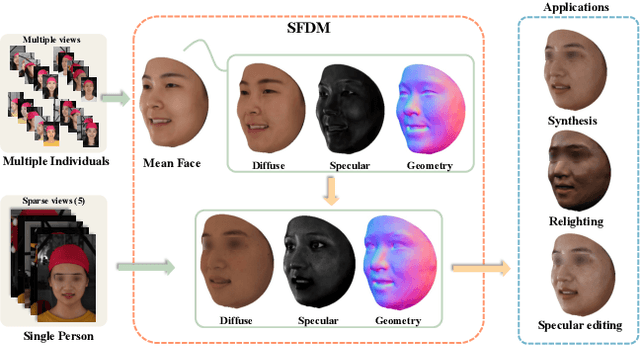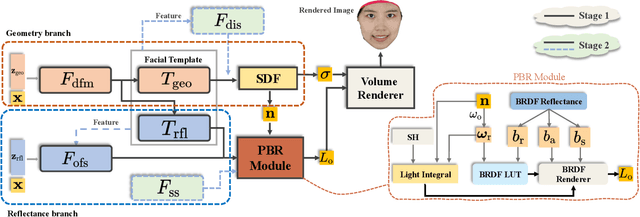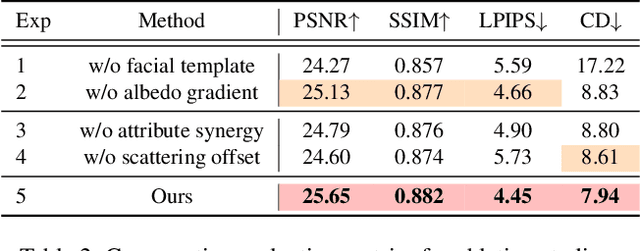Yuxin Dai
MIRReS: Multi-bounce Inverse Rendering using Reservoir Sampling
Jun 25, 2024



Abstract:We present MIRReS, a novel two-stage inverse rendering framework that jointly reconstructs and optimizes the explicit geometry, material, and lighting from multi-view images. Unlike previous methods that rely on implicit irradiance fields or simplified path tracing algorithms, our method extracts an explicit geometry (triangular mesh) in stage one, and introduces a more realistic physically-based inverse rendering model that utilizes multi-bounce path tracing and Monte Carlo integration. By leveraging multi-bounce path tracing, our method effectively estimates indirect illumination, including self-shadowing and internal reflections, which improves the intrinsic decomposition of shape, material, and lighting. Moreover, we incorporate reservoir sampling into our framework to address the noise in Monte Carlo integration, enhancing convergence and facilitating gradient-based optimization with low sample counts. Through qualitative and quantitative evaluation of several scenarios, especially in challenging scenarios with complex shadows, we demonstrate that our method achieves state-of-the-art performance on decomposition results. Additionally, our optimized explicit geometry enables applications such as scene editing, relighting, and material editing with modern graphics engines or CAD software. The source code is available at https://brabbitdousha.github.io/MIRReS/
Robust Geometry and Reflectance Disentanglement for 3D Face Reconstruction from Sparse-view Images
Dec 11, 2023



Abstract:This paper presents a novel two-stage approach for reconstructing human faces from sparse-view images, a task made challenging by the unique geometry and complex skin reflectance of each individual. Our method focuses on decomposing key facial attributes, including geometry, diffuse reflectance, and specular reflectance, from ambient light. Initially, we create a general facial template from a diverse collection of individual faces, capturing essential geometric and reflectance characteristics. Guided by this template, we refine each specific face model in the second stage, which further considers the interaction between geometry and reflectance, as well as the subsurface scattering effects on facial skin. Our method enables the reconstruction of high-quality facial representations from as few as three images, offering improved geometric accuracy and reflectance detail. Through comprehensive evaluations and comparisons, our method demonstrates superiority over existing techniques. Our method effectively disentangles geometry and reflectance components, leading to enhanced quality in synthesizing new views and opening up possibilities for applications such as relighting and reflectance editing. We will make the code publicly available.
FuseSR: Super Resolution for Real-time Rendering through Efficient Multi-resolution Fusion
Oct 15, 2023Abstract:The workload of real-time rendering is steeply increasing as the demand for high resolution, high refresh rates, and high realism rises, overwhelming most graphics cards. To mitigate this problem, one of the most popular solutions is to render images at a low resolution to reduce rendering overhead, and then manage to accurately upsample the low-resolution rendered image to the target resolution, a.k.a. super-resolution techniques. Most existing methods focus on exploiting information from low-resolution inputs, such as historical frames. The absence of high frequency details in those LR inputs makes them hard to recover fine details in their high-resolution predictions. In this paper, we propose an efficient and effective super-resolution method that predicts high-quality upsampled reconstructions utilizing low-cost high-resolution auxiliary G-Buffers as additional input. With LR images and HR G-buffers as input, the network requires to align and fuse features at multi resolution levels. We introduce an efficient and effective H-Net architecture to solve this problem and significantly reduce rendering overhead without noticeable quality deterioration. Experiments show that our method is able to produce temporally consistent reconstructions in $4 \times 4$ and even challenging $8 \times 8$ upsampling cases at 4K resolution with real-time performance, with substantially improved quality and significant performance boost compared to existing works.
 Add to Chrome
Add to Chrome Add to Firefox
Add to Firefox Add to Edge
Add to Edge